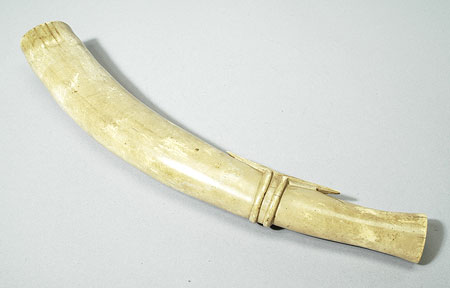Accession Number:
1940.12.611
Country:
Congo, Democratic Republic of
Cultural Group:
?Zande
Date Made:
By 1940
Materials:
Elephant Tooth Ivory Animal
Process:
Carved , Hollowed , Perforated , Polished
Dimensions:
L = 415, L from finger-hole to embouchure = 100; proximal end diam = 39 by 30, diam finger-hole = 11; mouthpiece L = 97.4, W = 33; embouchure diam = 25; bell mouth diam ext. = 56 by 40.5, diam int. = 54 by 38 mm [RTS 21/2/2005].
Weight:
674.4 g
Other Owners:
Charles Gabriel Seligman
Field Collector:
? Charles Gabriel Seligman & ?Brenda Zara Seligman
PRM Source:
Charles Gabriel Seligman or Brenda Zara Seligman
Acquired:
Donated 1940
Collected Date:
By 1940
Description:
Side-blown trumpet carved from a single piece of cream-coloured ivory (Pantone 7401C), discoloured grayish cream along one side (Pantone 7502C).
This has been hollowed out and then polished over the exterior surface to remove the tool marks.
The trumpet has a narrow, flat-cut proximal end with strongly oval section; a circular opening has been cut through this to create a finger-hole to vary the note.
A wide, circular embouchure has been cut from the concave side of the tusk into the body of the trumpet.
This area has been embellished with a mouthpiece surround, carved to stand proud of the body surface.
The front of this mouthpiece consists of an angular, lozenge-shaped section that divides into 2 sharp points at either end, with a deep v-shaped cut between.
These points extend out from the body of the mouthpiece to stand free of the surface, and have been carved in the round.
The upper surface follows the convex curve of the horn body.
2 rounded, raised collars extend from the sides of this mouthpiece, to run around the back.
These have a deep, flat based groove cut between them, that stops at the end of each collar and splits into 2 narrower grooves that run left and right, parallel to the outside edges of the mouthpiece surround.
These frame the embouchure and emphasise the shape of the mouthpiece itself.
There are faint traces of reddish brown material in part of the broader groove and running alongside the edge of the collar.
Below the mouthpiece, the body of the trumpet follows the natural curvature of the parent tusk, gradually expanding towards the bell mouth, where the surface undulates slightly; the mouth is thin walled and markedly oval in section.
The trumpet is essentially complete, except for a small chip at the distal end.
It has a weight of 674.4 grams and is 415 mm long.
The proximal end measures 39 by 30 mm across, and has a finger-hole diameter of 11 mm; the mouthpiece is 97.4 mm long and 33 mm wide in the section surrounding the embouchure; the embouchure itself has a diameter of 25 mm at its top edge.
The length from finger-hole to the edge of the embouchure is 100 mm, and the bell mouth has an external diameter of 56 by 40.5 mm, and an internal diameter of 54 by 38 mm.
This object was amongst material donated to the Pitt Rivers Museum in 1940, from the collection of Charles Gabriel Seligman and his wife Brenda Zara Seligman. It may have originally come to them from E.E. Evans-Pritchard.
Ivory trumpets of this type appear to have been status items, sometimes used in war. Wood, for example, says that "some of the officers, or leaders, have large war trumpets made of elephant's tusks... they are sounded from the side, like a flute", illustrating examples made in a single piece, or of wood and ivory bound together (J.G. Wood, 1868, The Natural History of Man Vol. I, p. 493). Larken also discusses this type of object: "The powerful Vungara Chief Ndoromo, grandfather of Zungumbia of the Tambura District, had a magnificent trumpet made out of an elephant tusk, carved and lapped in skin... No doubt these trumpets were used in Court ceremonial, for they seem only to have been in the possession of the paramount Chiefs" (P.M. Larken, 1927, "Impressions of the Azande", Sudan Notes and Records X , p. 105).
Rachael Sparks 19/9/2005.
This object was amongst material donated to the Pitt Rivers Museum in 1940, from the collection of Charles Gabriel Seligman and his wife Brenda Zara Seligman. It may have originally come to them from E.E. Evans-Pritchard.
Ivory trumpets of this type appear to have been status items, sometimes used in war. Wood, for example, says that "some of the officers, or leaders, have large war trumpets made of elephant's tusks... they are sounded from the side, like a flute", illustrating examples made in a single piece, or of wood and ivory bound together (J.G. Wood, 1868, The Natural History of Man Vol. I, p. 493). Larken also discusses this type of object: "The powerful Vungara Chief Ndoromo, grandfather of Zungumbia of the Tambura District, had a magnificent trumpet made out of an elephant tusk, carved and lapped in skin... No doubt these trumpets were used in Court ceremonial, for they seem only to have been in the possession of the paramount Chiefs" (P.M. Larken, 1927, "Impressions of the Azande", Sudan Notes and Records X , p. 105).
Rachael Sparks 19/9/2005.
Primary Documentation:
Accession Book Entry
[p.
468]
The late Professor C.G.
SELIGMAN, M.D., F.R.S.
Miscellaneous collection presented in part by himself, June, 1940, and in part, after his death, by Mrs B.Z.
Seligman, October, 1940.
[p.
501] 1940.12.611 [sketch of trumpet], [p.
502] 1940.12.611 - Side-blast trumpet of ivory, 16 ins long.
CENTRAL AFRICA (?AZANDE).
?Card Catalogue Entry - Side-blast trumpet of ivory. Mouthpiece shaped decoratively with carved bands around the outside.
Written on object - Side-blast trumpet of ivory. CENTRAL AFRICA (?AZANDE). d.d. Dr C.G. Seligman [RTS 21/2/2005].
?Card Catalogue Entry - Side-blast trumpet of ivory. Mouthpiece shaped decoratively with carved bands around the outside.
Written on object - Side-blast trumpet of ivory. CENTRAL AFRICA (?AZANDE). d.d. Dr C.G. Seligman [RTS 21/2/2005].








